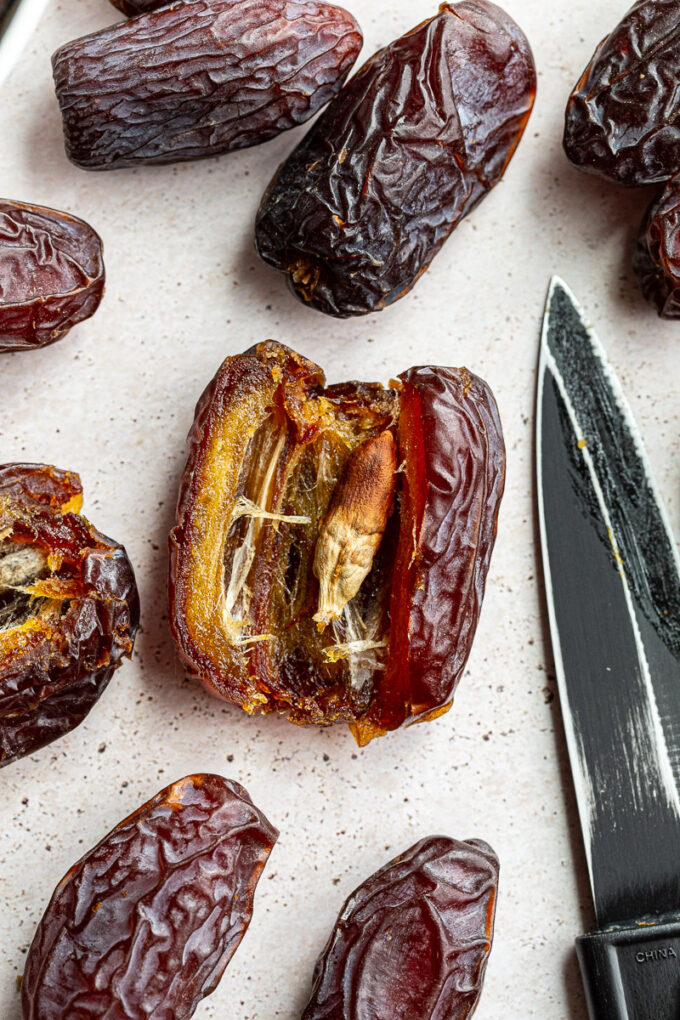This post may contain affiliate links. Please read our disclosure policy.
Interested in learning more about the wonder fruit of DATES!? Look no further! I’m going to tell you everything from what dates actually are, their history, and everything about their nutritional info!

It’s no secret that I LOVE dates! I’ve posted many many date recipes over the years and have really fallen in love with this wonder fruit. I often get questions about dates, where they come from, etc; SO I figured that I would write a blog post tell you everything I know about them.
There are many different types of dates (although a few common varieties that you are most likely to find in your area) and they’re all a little different. But, let’s start with the basics, shall we?

What is a Date Fruit?
Wait, is date a fruit??
Dates are indeed a FRUIT that comes from date palm trees. These are tropical trees that were originally found in Northern Africa (such as in Morocco) as well as in the Middle East. Dates fruit is now grown across the world including in the US in places such as California.
The seeds of the tree grow inside of the fruit which eventually ripens and becomes when we enjoy: DATES! In the picture above, you can see the unripened dates growing on the palm trees. They grow in big bunches and are green before ripening (and eventually turning the dark color that we are familiar with).
One date palm tree can grow over 200 pounds of dates every single year!

Varieties of Dates
There are many different varieties of dates but just a few that you will commonly find at your local grocery store. By far the most popular in North America is the Medjool Date (pictured above). These dates are about 1 1/2-2 inches long on average and have a large seed in the middle that must be removed before consumption or cooking takes place.
Other common varieties of date fruits include Omani dates (smaller and smoother in appearance), halawy dates (a smaller yellow date), and mazafati dates (similar in look to medjool dates).

Nutritional info of medjool dates:
Dates are packed with nutrition and despite their high sugar count, they’re truly a delicious and healthy food! They have 50% more potassium than bananas!
Let’s break down some of the specifics. Per 3 medium medjool dates (46 grams):
- Calories- 140
- Carbohydrates- 33g
- Dietary fiber- 4g
- Total sugars- 33g
- Protein- 1g
- Potassium- 10% daily value of potassium
- Iron- 3% daily value of iron
- Calcium- 3% daily value of calcium
- Total fat- 0g
- Cholesterol- 0g
- Sodium- 0g

Date Recipes to try:
As I mentioned, I’ve posted a lot of truly delicious date recipes. Here are some of my favorites-
- Stuffed Dates 2 ways
- Chewy Granola Bars
- Healthy Homemade Snickers
- Date Sweetened Oat Milk
- Date Sweetened Peanut Butter Cups
- Date Nut Bars
- Oatmeal Date Cookies
- Strawberry Banana Smoothie
- Carrot Cake Smoothie
- Date Paste
- Stuffed Dates- 2 different ways
- Date Kale Salad
- Chocolate Date Sweetened Pie with Date Crust
How to properly store dates:
While dates can most certainly be stored in an air tight container at room temperature, I suggest storing them in the fridge or even the freezer is you don’t plan to eat all of them within a couple of weeks.
Similar to raisins, the dates won’t necessarily go bad after a couple weeks but they will harden and be significantly less enjoyable to eat.
How to soften dates: if you have some older, firmer dates that you would like to use in a recipe or smoothie, I suggest soaking the dates in hot water for about 30 minutes. When you’re ready to use them, you can remove from the water and squeeze out most of the excess liquid.

The above photo is courtesy of Natural Delights. These are some of their trees in the Bard valley. Their dates are grown across the valley in California, Arizona, and Mexico. The white bags you see in the photos are put there to collect the date fruits as they ripen and fall off of the tree.










